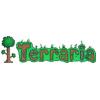 Game: Terraria
Game: Terraria
Developer: Re-Logic
Publisher: 505 Games
Available On: PC, Xbox 360, Playstation 3
Reviewed on: Xbox 360
It’s 2D Minecraft!
Well, that was easy. Wrap this one up and ship it to the GiaG mainframe, I’m off for a cup of tea.
I jest, of course. While Terraria bears a staggering degree of similarity to Mojang’s brick-by-brick sandbox – so much so that the analogy isn’t wrong – Terraria is also noticeably more ‘gamey’. To simply describe Terraria as 2D Minecraft and waltz away is akin to calling a Tikka Massala a slightly spicy Korma: you’d be missing the depth of difference just because they’re both curry.
Not all of the differences between Terraria and Minecraft are for the better, but they’re all far from insignificant. Some will likely prefer Terraria’s retro spin on the mine and build formula, some will appreciate the more typically game-like expansions, and some will damn it for “missing the point” entirely. This has already been established with the game’s initial PC release but this new console translation brings it to a new audience along with a slew of extra content alongside controls based around a pad. It’s time to argue the differences anew.
STORY: In every way the cliché can be spun, Terraria is your story. Dumped into your own, randomly generated world next to a personality-free NPC you’re given all the encouragement normally offered to a tumbleweed in establishing your life and penning your tale.
Terraria practically requires you to dip into its help option and achievements to glean any modicum of encouragement. Do so, and you’ll find out that you should probably chop down a few trees and build a box to hide in overnight, as well as learning that there exists an underworld and a handful of bosses somewhere in your world that you might, one day, want to find and fight.
If you’re not the sort that enjoys striking out on your own path, armed with only a stick and an eye with which to to revel in the discovery of the unknown, then Terraria is not for you. However, if you are of the disposition where you prefer a blank page upon which to make your mark then Terraria offers you a notepad without uttering a single syllable. Have at it, hero. It’s not for everyone, certainly, and while the lure of powerful bosses does do something to avoid the premise being quite as blank-faced as Minecraft’s, it’s still absolutely up to the player to plant, cultivate and nurture their own personal tale.
GRAPHICS: Terraria looks fine but it lacks the strong visual consistency and identity that supports its three dimensional cousin. There’s just nothing special about Terraria’s look, with its enemies and “my first sprite” characters that stare, emotionless, toward the middle distance. The world also feels every bit the restricted piece-by-piece construction that it is, due largely to the reliance on “walls” in the game’s interior construction. In a wholly restrictive way, it feels every bit the 2D game that it is.
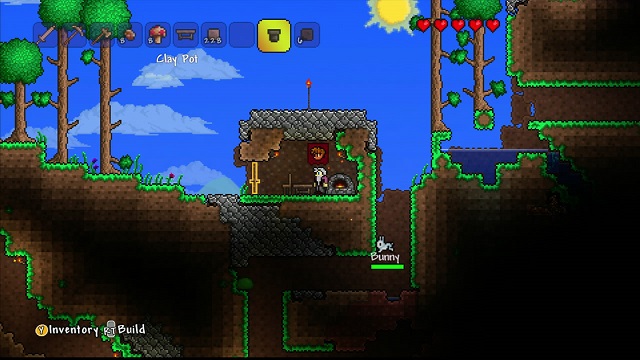
Where the game shines, pardon the pun, is in its lighting. There are so many things that affect light in Terraria, from moss hanging on cave ceilings to your depth underground, that create a tangible sense of foreboding as you dig deeper and deeper, clinging to what tiny speck of illumination you have left so far in the darkness. The game has its moments, and there’s a nice bit of variety, it just never manages to genuinely impress with its visuals.
SOUND: Terraria’s sound is insistent. Sound effects comprise of minimal grunt, moans and clangs that I’d filtered out after an hour or so but the music in Terraria borders on infuriating. They’re good compositions in isolation but their frequency and pace during gameplay creates a sound-scape that finds itself at frequent odds with your intentions and actions as the player.
It’s because the tracks are constantly cycling, day and night, driving against your brain like an intent bulldozer. If there were a handful of different music tracks that offered some variety then it would be lovely but there really aren’t; with one track per environment you’ll quickly be muting them in the options and be left with the clink, clink, clang of your digging. It’s not that the sound isn’t special or good because, as I said, the music is good when taken in small doses – but it really grates against the gameplay and your mind far too often for it to be considered a success within the context of the game.
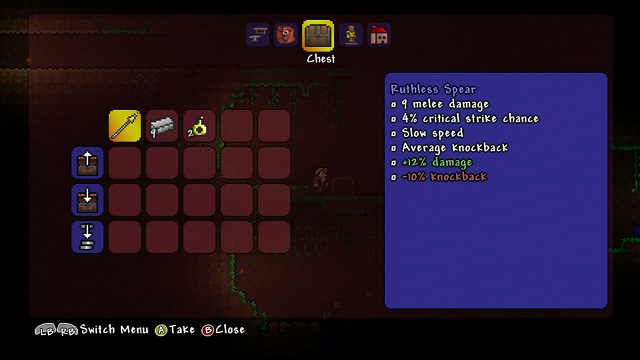
GAMEPLAY: Terraria is a game about building. Building a house, or armour, or weapons or statues. There are bosses in the world, but you don’t have to fight them. There are things in the sky, but you don’t have to go up there. There are loads of plants and silly ornamental things you can put in your house, or in a cave, or outside. Or not. To be honest, you don’t really have to build.
Terraria is one of those games, the sort of “do it yourself” adventure with the one loose rule that monsters mostly come out at night. Mostly. The 2D Minecraft comparison rears its head most prominently here considering that Terraria adheres to many of that game’s quirks and ideas. Use tools to gather materials, then craft materials into new tools and things for the advancement of your terra-forming campaign. You can even do the “place block under you as you jump” thing you can do in Mincraft, though in Terraria a Harpy will likely knock you down to your death…
That’s the biggest difference between Terraria and Minecraft, besides the perspective shift. Terraria is far more typical in its game-like ideas. More enemies, yes, but also inexplicable cave-dwelling loot chests with stat-laden weaponry and epic gear. Chests you sometimes can’t open without the right tools, as well.
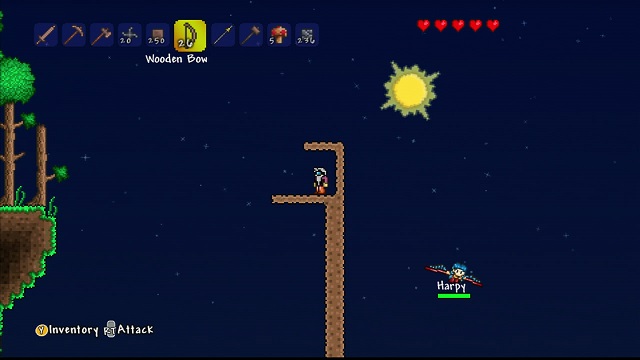
Terraria is also a far faster game than Minecraft, but this works against it as much as for it. Your tools never break, and the starting pickaxe really has no problems taking you to the bottom of the map, which is liberating but means that the game lacks the clever, soft gear-locks of Minecraft. Mojang’s game forced you to gear up through environmental blocks; Terraria is more concerned with your armour and weapons, as enemies and your death are the only real ways it has of saying “Shouldn’t go there yet, mate.” Cue a spelunking expedition for your lost gear. It’s far less subtle, and that’s telling of Terraria as a whole.
The game moves as if everyone is on rollerskates, and the world is made of tiny, tiny, inconsequential blocks. It just never feels like your movement or interactions have the weight that they should have. Building an abode on a hill is fine and fun but you’ll rarely get the perspective that anything you’re doing is in any way “grand”, or that any of the underground areas you come across have any age or splendour. It’s all very much alright.
Get into Terraria, though, and it does become more of a treat with extended play. Rocket boots, wings, grappling hooks, guns; the toys and tools the game holds back for those that explore its depths (literally) are very fun and offer something very unique to those that put the grind in. As I said it’s frequently more typically game-y than Minecraft, both to its credit and detriment, but as long as you hop in expecting something a little less refined then it plays a fine game indeed (once you discover that clicking the right stick switches between precision and general aiming methods).
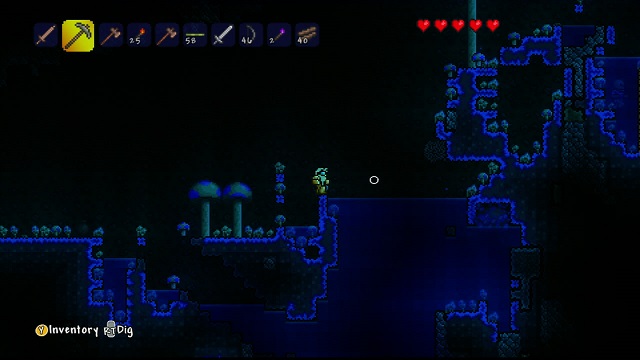
MULTIPLAYER: Terraria offers the option for four-player splitscreen play as well as eight players inhabiting the same world online. Splitscreen play does suffer slightly from slowdown and other hiccups, such as the way editing a sign stops play for all involved, meaning that online is still the optimal way to play – but it’s nice to see splitscreen supported.
Terraria’s most interesting multiplayer feature is the ability to enable PvP and assign players to one of four teams. This opens the game up to some seriously smart and varied multiplayer shenanigans, and with eight players all partaking in a spot of mining or fort vs. fort PvP the game comes alive in a dramatic way.
LONGEVITY: Terraria is a big “thing”, but as with any game of this nature it’s completely in the hands of the player to get what they want to get from it. To Terraria’s credit it keeps delivering new and funky tools as you dig deeper and deeper into the game, and the gear side of things ensures that you can still surprise friends with an item every now and again, ensuring you’ll rarely play Terraria just to build, or just to explore.
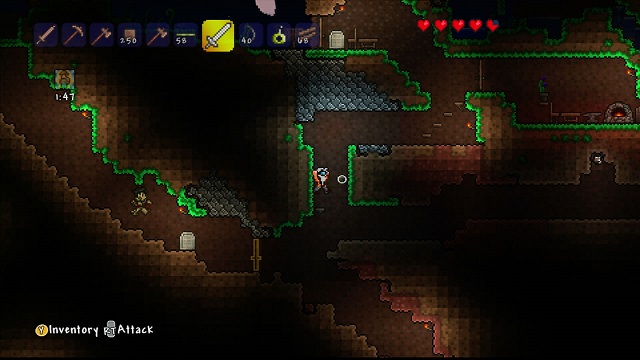
Even if you’re not the sort to hunt achievements and call it a wrap only when you’re sitting on full Gamerscore or a Platinum Trophy, Terraria still pushes an impressive, double-digit playtime. Defeating all of your world’s bosses opens up a harder difficulty full of more bosses, and taking them down is far from easy. If you have no problems pushing yourself towards a seemingly invisible goal, then Terraria will definitely have you pushing for weeks, or even months.
VERDICT: It’s 2D Minecraft that’s a little less refined but includes lots of bosses and gear! There we go, is that good enough? I’m really hankering for a cup of tea, you see.
It’s the unrefined elements that let Terraria down: The movement pace that makes it feel as if you’re always bursting for a pee, the all-powerful wooden pickaxe that makes progress and digging feel largely inconsequential, and the rubbish water physics. Terraria is far from bad, it’s just a game that hits you with interesting ideas and squiffy design elements in equal measure. As I’ve already said, some will absolutely prefer Terraria to its 3D cousin thanks to everything that makes it different, and anyone that enjoyed Minecraft should definitely give Terraria a giggle, but it is a noticeably less arresting and compelling game when examined block by block.



